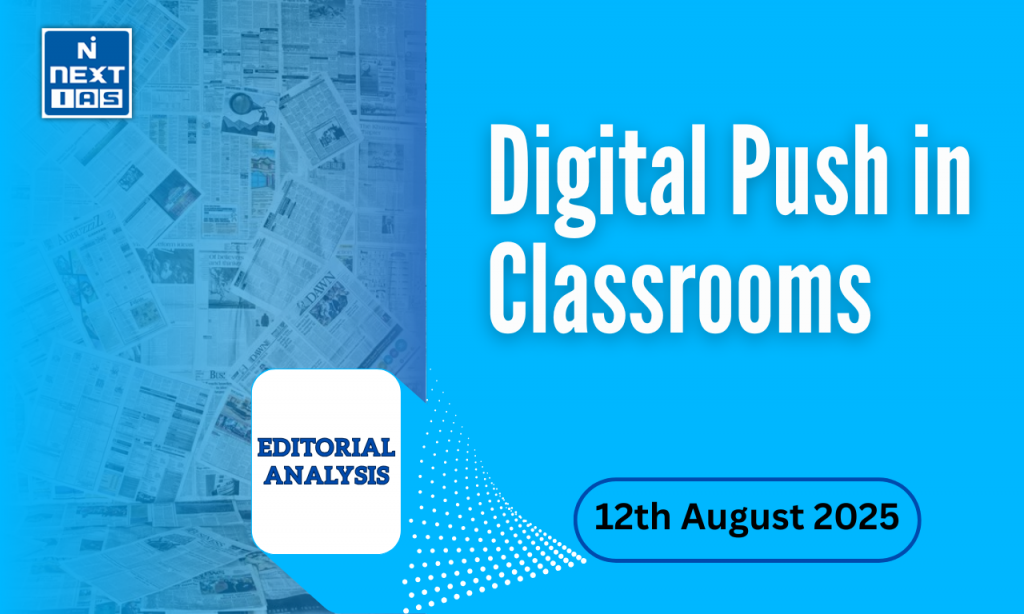
Syllabus: GS2/Education; GS3/Role of IT
Context
- Technological advancements, such as the complete switchover to digital systems, reveal the unintended consequences of over-reliance on artificial intelligence (AI) and digital tools.
India’s Digital Push
- India’s ambitious digital transformation in education — accelerated by the pandemic and sustained by policy — has undeniably reshaped classrooms.
- India’s digital push democratizes learning from smartboards and tablets to online assessments and virtual learning platforms.
Vision and Policy Framework
- The digital education drive is anchored in the Digital India initiative and reinforced by the National Education Policy (NEP) 2020, which emphasizes:
- Equitable access to technology;
- Multilingual digital content;
- Teacher empowerment through ICT;
- Integration of AI and emerging tech in pedagogy;
- Role of AI and EdTech: AI is reshaping classrooms by:
- Assisting teachers with lesson planning and assessments;
- Offering personalized learning paths based on student performance;
- Supporting regional language content for inclusivity.
- In Bengaluru, AI-enabled voice tools like Tara are helping first-generation learners improve English skills, showing how tech can complement traditional teaching.
Key Efforts: Digital Push in Education
- Union Budget (2025): It reinforced India’s commitment to emerging technologies:
- ₹500 crore allocated for AI in education;
- 10,000 fellowships for deep-tech research;
- Expansion of Atal Tinkering Labs and Centres of Excellence.
- Additionally, over 56,000 smart classrooms and 2,600+ computer labs have been set up in government schools to strengthen digital infrastructure.
- Digital India: It is aimed to bridge the digital divide and make technology a tool for inclusive development, from rural villages to urban metros. It was conceived with three core objectives:
- Digital Infrastructure as a Utility to Every Citizen;
- Governance and Services on Demand;
- Digital Empowerment of Citizens;
- Other efforts like PM e-Vidya Programme, DIKSHA, SWAYAM, ePathshala, NISHTHA, and Atal Tinkering Labs fuel the digital push for education in India.
Challenges and Gaps
- Digital & Access Divide: Only 32.4% of schools have functional computers; rural areas lag behind.
- Millions of students still lack access to smartphones, laptops, or reliable internet.
- ASER Survey (2021) found that nearly 30% of students in rural India had no access to a smartphone at home.
- Infrastructural Deficits: Many schools lack basic amenities like safe classrooms and toilets.
- Erratic power supply and poor network coverage make digital learning inconsistent, even when devices are available.
- Language and Literacy Barriers: Many platforms are English-centric, leaving non-English speakers and first-generation learners struggling to engage.
- Teacher Training: Limited ICT training hampers effective tech integration.
- Data Privacy: Concerns over student data collection and AI surveillance remain
Empathy Deficit: When Tech Overshadows Human Connection
- Education is about connection, care, and understanding, along with content delivery.
- Empathy, once the cornerstone of good teaching, risks being sidelined in the race for digital efficiency.
- Teacher-Student Disconnect: Virtual platforms limit spontaneous interactions, making it harder for teachers to gauge emotional cues or offer personalized support.
- Mental Health Strain: Isolation, screen fatigue, and pressure to perform digitally have taken a toll on students’ mental well-being.
- One-Size-Fits-All Approach: Algorithms and standardized modules often ignore individual learning styles, cultural contexts, and emotional needs.
Case Study: Hidden Cost of Digital-First Approach
- Maharashtra Anganwadi Case: An Anganwadi in Maharashtra recently introduced AI-powered equipment and digital devices to aid early learning. A three years old child confidently used an interactive smart board, while another explored a virtual jungle via an AI headset
- However, such initiatives risk detaching young children from real-world experiences vital for cognitive and emotional growth.
- Early childhood education already suffers from low priority; replacing relational, sensory-based learning with virtual tools could erode developmental foundations.
- Impact on Teachers: From pre-school to university, digital solutions are reshaping education, often diminishing teachers’ professional autonomy.
- Limited training and systemic neglect mean that teachers are increasingly sidelined in favor of automated systems, further weakening the education ecosystem.
Way Forward: Rethinking the Digital Push
- Hybrid Models: Blending digital tools with traditional teaching can ensure inclusivity and preserve human connection.
- Localized Content: Platforms must offer multilingual, culturally relevant material to engage diverse learners.
- Teacher Training in Empathy: Digital literacy should go hand-in-hand with emotional intelligence training for educators.
- Community-Based Access: Shared digital hubs in villages and urban slums can democratize access where personal devices are scarce.
| Daily Mains Practice Question [Q] Critically examine how the digital push in classrooms has impacted both access to education and the emotional connection between teachers and students. |
Next article
ELI Scheme: Debunking the Myth of Job Creation